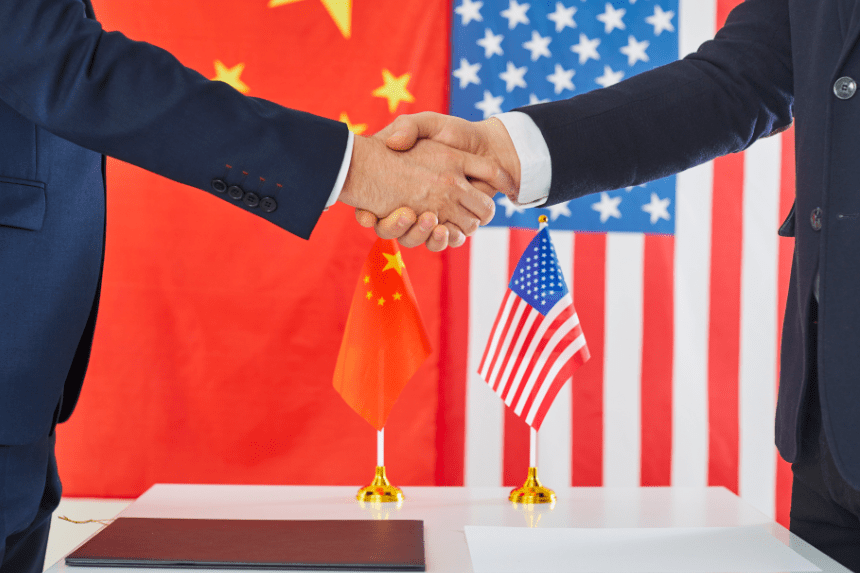The recently announced US-China trade deal framework marks a significant, though limited, breakthrough in global trade diplomacy. This agreement, developed after two days of intensive negotiations in London, signals an effort by the world’s two largest economies to ease rising tensions and restore productive economic ties. While the deal is not yet finalized and awaits approval from Presidents Donald Trump and Xi Jinping, it reflects a shift from confrontation to cautious cooperation.
- What Triggered the New Talks Between the US and China?
- What Are the Key Elements of the US-China Trade Deal Framework?
- How Is the US Responding to This Agreement?
- Why Is the US-China Trade Deal Framework So Important Now?
- What Are the Remaining Challenges?
- How Will This Affect Businesses and Global Markets?
- Conclusion
Both sides have committed to taking immediate steps to de-escalate trade restrictions that have disrupted key industries, slowed economic growth, and stirred global market volatility. The US-China trade deal framework may not resolve all disputes, but it serves as a foundation for deeper engagement in the months ahead.
What Triggered the New Talks Between the US and China?
Trade tensions between the United States and China had been building for several months due to a series of tariff hikes. In response to US tariffs on hundreds of billions worth of Chinese goods, Beijing retaliated with its measures. This tit-for-tat approach destabilized global supply chains and cast uncertainty over markets worldwide.
Recognizing the risks of a prolonged trade war, both countries agreed in May to a temporary truce. The truce reduced US tariffs on Chinese imports from 145% to 30%, while China brought its tariffs on US goods down to 10%. It also set a 90-day window for both sides to reach a lasting agreement.
Despite that initial progress, tensions flared again after allegations of violations related to non-tariff promises, including delays in mineral exports from China and continued US restrictions on Chinese access to high-tech components and academic exchanges. These issues reignited talks and led to the creation of the US-China trade deal framework.
What Are the Key Elements of the US-China Trade Deal Framework?
The core of the US-China trade deal framework revolves around reciprocal concessions aimed at de-escalating current tensions. China has agreed to resume and prioritize the export of critical rare earth minerals and industrial magnets. These materials are essential for the manufacturing of electric vehicles, smartphones, wind turbines, and other advanced technologies, many of which rely on stable and predictable supply chains.
In exchange, the United States will withdraw threats to impose visa restrictions on Chinese students pursuing studies in STEM fields and ease selected trade restrictions targeting AI and semiconductor-related exports. The agreement also includes a shared commitment to continue discussions on outstanding disputes in a structured and transparent manner.
While the framework does not replace the Geneva consensus reached earlier this year, it clarifies its terms and creates a roadmap for enforcement and future steps.
How Is the US Responding to This Agreement?
President Trump announced that the US will be issuing formal letters to its trade partners, including China, detailing new tariff terms and future expectations. These letters are expected to outline timelines and conditions for further cooperation. If countries continue to engage in good faith, the administration has signaled a willingness to delay the reimposition of higher tariffs.
According to White House officials, President Trump is reviewing the terms of the new US-China trade deal framework and has responded positively. “What the president heard, he liked,” said a press spokesperson, pointing to the administration’s satisfaction with the initial outcomes of the London talks.
Commerce and Treasury officials have further emphasized that the framework reflects a practical step forward without undermining America’s broader trade objectives. One official described the process as “cleaning up the Geneva agreement” and ensuring clearer implementation pathways.
Why Is the US-China Trade Deal Framework So Important Now?
The importance of the US-China trade deal framework lies in its timing and the strategic sectors it addresses. With both countries under economic pressure at home and facing global scrutiny abroad, there is growing recognition that prolonged trade conflict is unsustainable.
For the US, ensuring access to rare earth minerals and components is crucial for industries shifting toward green energy and next-generation technologies. For China, removing the threat of tightened student visa policies and resuming access to certain technologies supports both innovation and education.
Beyond bilateral benefits, this framework offers reassurance to global markets. It shows that despite deep divisions, the US and China are still capable of engaging in structured dialogue. For businesses and investors, this reduces immediate uncertainty and encourages long-term planning. Read another article on US-China Trade War Global Impact
What Are the Remaining Challenges?
Despite the progress, the US-China trade deal framework is not a comprehensive resolution. Key areas of disagreement persist, particularly around technology access, data governance, intellectual property rights, and enforcement mechanisms.
There are also concerns about whether both sides will honor their commitments. Past deals have suffered due to vague language and differing interpretations. A critical factor for the success of this framework will be the establishment of clear, enforceable mechanisms and regular oversight.
Additionally, political considerations on both sides may complicate further talks. With elections looming in the US and strategic ambitions growing in China, leaders face internal pressures that could influence how far they’re willing to compromise.
How Will This Affect Businesses and Global Markets?
For global businesses, the US-China trade deal framework is a cautiously optimistic development. It restores a level of predictability and reduces the immediate risk of punitive trade actions. Sectors such as automotive, electronics, renewable energy, and education stand to benefit the most in the short term.
Exporters and manufacturers in both countries may now reconsider paused investments and supply chain shifts. However, until more permanent agreements are reached, companies will likely continue diversifying suppliers and mitigating risk through strategic planning.
Market analysts suggest that the framework could help stabilize commodity prices, particularly those linked to rare earths and semiconductors, which have seen volatility in recent months due to trade uncertainty.
Conclusion
The US-China trade deal framework represents an important step in resetting trade relations between the two global powerhouses. While not a final deal, it addresses immediate concerns, reaffirms shared interests, and provides momentum for continued dialogue.
By committing to transparency and balanced concessions, both nations have signaled a willingness to move beyond escalation. As talks continue, businesses, investors, and policymakers must stay informed and prepared for both opportunities and challenges ahead.
With sustained diplomacy and action-oriented implementation, this framework could lay the foundation for a more stable and cooperative global trade environment.








